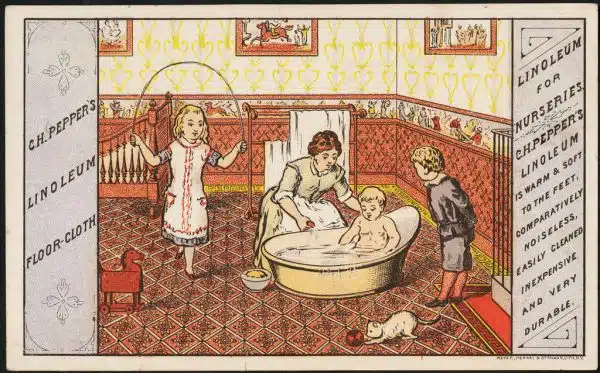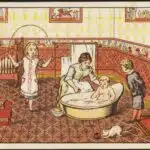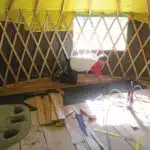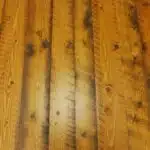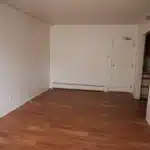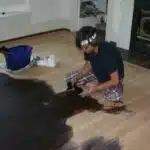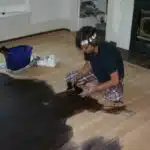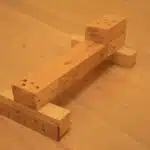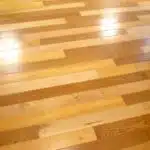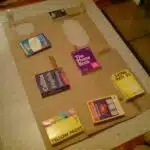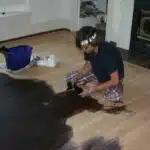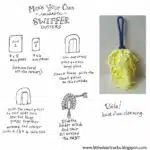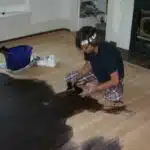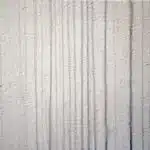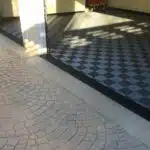Linoleum floors have been a popular choice for homeowners and commercial spaces since the late 1800s. Its durability, affordability, and easy maintenance make it an ideal flooring option for high traffic areas. However, over time, linoleum floors can accumulate dirt, grime, and stains that can affect its appearance and longevity.
Cleaning linoleum floors is an essential task to ensure their longevity while maintaining their aesthetic appeal. In this article, we will discuss the best practices to clean linoleum floors effectively. Whether you are a homeowner or a commercial space owner looking for ways to maintain your linoleum flooring investment, this article will provide you with expert insights on how to keep your floors looking sparkling clean for years to come.
Understanding The Properties Of Linoleum Floors
Linoleum floors are a popular choice for homeowners who want an eco-friendly and durable flooring option. Despite being mistaken as vinyl, linoleum is made from natural materials such as linseed oil, wood flour, and cork dust. These components make linoleum floors a great alternative to synthetic options that are harmful to the environment.
One of the benefits of linoleum floors is their durability. They are abrasion-resistant and can withstand heavy foot traffic with ease. Unlike other flooring types, they do not easily scratch or dent, making them long-lasting and cost-effective in the long run. Moreover, linoleum floors can be repaired when damaged by replacing the affected area instead of having to replace the entire floor.
Linoleum floors are also easy to maintain due to their smooth surface that does not trap dirt or dust particles easily. This feature makes cleaning effortless and straightforward using simple household tools like mops and brooms. Additionally, they do not require harsh chemicals for maintenance, which makes them a healthy choice for individuals with allergies or respiratory issues. Understanding these properties of linoleum floors is critical before embarking on cleaning them to ensure proper care and maintenance is taken into account when doing so.
Moving forward, it’s important first to identify different types of stains on linoleum floors before undertaking any cleaning process.
Identifying Different Types Of Stains On Linoleum Floors
Understanding the Properties of Linoleum Floors is essential before learning how to clean them. Linoleum floors are made of natural materials like linseed oil, rosin, and wood flour. These materials make the floors durable, water-resistant, and eco-friendly. However, linoleum floors are susceptible to stains caused by spills and foot traffic. Stains can be challenging to remove if not treated immediately.
Removing stains from linoleum floors requires proper identification of the stain type. The most common types of stains on linoleum floors are food stains, grease stains, ink stains, and pet urine stains. Each type of stain requires a specific cleaning solution and technique for effective removal. For instance, food stains can be removed using warm water mixed with dish soap or vinegar solution while oil-based grease stains require a mixture of baking soda and warm water.
Preventing stains on linoleum floors is crucial in maintaining their aesthetic appeal and longevity. Regular sweeping or vacuuming helps to prevent dirt build-up that can lead to discoloration or staining over time. Spills should be wiped up immediately using a clean cloth or paper towel to prevent penetration into the floor material. Placing doormats at entry points helps to trap dirt and moisture that might damage the floor’s surface.
Preparing your cleaning tools and solutions is necessary before attempting to clean your linoleum floors effectively. Gather all your cleaning supplies such as a bucket, mop, broom, vacuum cleaner, cleaning agent (vinegar solution or dish soap), baking soda, and warm water in readiness for use. Ensure that all your tools are clean before use to avoid introducing more dirt onto the floor surface during cleaning. With all these tools in place, you are now ready to start cleaning your linoleum floors effectively without causing any damage.
Preparing Your Cleaning Tools And Solutions
To achieve a clean and spotless linoleum floor, it is essential to prepare the appropriate cleaning tools and solutions. Choosing suitable cleaning tools is crucial as using the wrong ones can damage your flooring. When selecting cleaning tools, opt for those that are gentle on linoleum floors. Some of the best cleaning tools to use include brooms, microfiber mops, and vacuum cleaners with soft-bristle attachments.
Mixing the right cleaning solutions is equally important when preparing to clean linoleum floors. Most commercial floor cleaners contain harsh chemicals that can strip off the protective layer of your linoleum flooring over time. A safer alternative is to make your own natural solution by mixing equal parts of white vinegar and water in a spray bottle. This solution not only cleans but also disinfects your floors without leaving behind any residue or unpleasant odors.
To sum up, choosing appropriate cleaning tools and mixing the right cleaning solutions is imperative before embarking on cleaning your linoleum flooring. By doing this, you will effectively remove dirt and grime from your floors while preserving their shine and durability. In the next section, we will delve into removing loose dirt and debris before applying any cleaning solution to your floor surface.
Removing Loose Dirt And Debris
Before starting the cleaning process, it is essential to remove any loose dirt and debris from the linoleum floor. This step is crucial as it prevents the dirt from getting ground into the floor during cleaning, which can cause scratches and damage. The most effective way to remove loose dirt and debris is by using a vacuuming technique or sweeping tools.
Using a vacuum cleaner is an efficient method for removing loose dirt, dust particles, and other small debris from your linoleum floors. Ensure that you use the hard floor setting on your vacuum cleaner to avoid damaging the surface of your linoleum flooring. If you do not have a vacuum cleaner, you can use a broom or a dry mop to sweep off any debris before proceeding with cleaning.
Sweeping tools like brooms are also effective in removing loose dirt and debris from linoleum floors. However, it is crucial to use soft-bristled brooms or microfiber mops to avoid scratching or damaging the surface of your flooring. Sweep in one direction towards the center of the room instead of back-and-forth motions to prevent pushing dirt around on the floor. By using these methods, you can effectively remove loose dirt and debris from your linoleum flooring before proceeding with further cleaning steps.
Transition: Now that we have removed all loose dirt and debris from our linoleum floors using either vacuuming techniques or sweeping tools let’s proceed with cleaning them using vinegar and water solution for general cleaning.
Using Vinegar And Water Solution For General Cleaning
A vinegar and water solution is an effective and affordable way to clean linoleum floors. Vinegar has been used for centuries as a natural cleaning agent, and its acidic properties make it an excellent choice for removing dirt, grime, and stains from linoleum floors. Additionally, vinegar is non-toxic, making it a safe choice for households with pets or children.
One of the benefits of using a vinegar and water solution for general cleaning is that it can be easily made at home with common household items. This DIY approach can save money on expensive commercial cleaning products while still providing effective results. However, it is important to note that professional cleaning services may be necessary for heavily soiled or damaged linoleum floors.
To use vinegar and water solution for general cleaning of linoleum floors:
- Mix equal parts white vinegar and warm water in a spray bottle
- Spray the solution onto the floor in sections
- Use a damp mop or microfiber cloth to wipe away dirt and grime
- Rinse the mop or cloth frequently in warm water
- Allow the floor to air dry
In summary, using a vinegar and water solution for general cleaning of linoleum floors provides many benefits including affordability, effectiveness, and safety. While DIY approaches are convenient and cost-effective, professional cleaning services may be necessary for heavily soiled or damaged floors. By following the steps outlined above, homeowners can keep their linoleum floors looking clean and beautiful with minimal effort. In the next section, we will discuss how to apply baking soda and water solution for stubborn stains without causing damage to your linoleum flooring.
Applying Baking Soda And Water Solution For Stubborn Stains
After using the vinegar and water solution for general cleaning, you may come across stubborn stains that refuse to budge. Don’t worry; there’s still a solution for it. Baking soda and water work wonders to remove even the toughest of stains on linoleum floors. This method is not only effective but also eco-friendly and cost-efficient.
To apply this method, start by making a paste out of baking soda and water. Apply the paste directly onto the stain, let it sit for a few minutes, then scrub with a soft brush or cloth until the stain disappears. Rinse the area thoroughly with water and dry it off with a clean towel. You’ll be amazed at how easily and quickly this method removes stubborn stains without any harsh chemicals.
Although baking soda and vinegar solutions are excellent choices for low maintenance cleaning tasks, alternative stain removal methods can be used in more extreme circumstances. Commercial floor cleaners are designed specifically for heavy-duty cleaning tasks, like removing ground-in dirt or grease buildup. These cleaners come in various formulations depending on your specific needs – some contain enzymes to break down organic matter while others contain solvents that dissolve tough stains. When using commercial cleaners, always follow the instructions carefully to avoid damaging your linoleum floors.
Transitioning into the next section: While commercial floor cleaners are useful for deep-cleaning tasks, they’re not always necessary or environmentally friendly. In the following section, we’ll discuss how to use these cleaners effectively while minimizing their impact on our surroundings and health.
Using Commercial Floor Cleaners For Heavy-Duty Cleaning
When it comes to heavy-duty cleaning of linoleum floors, commercial floor cleaners can be a great option. These cleaners are specially designed for use on various types of floors, including linoleum, and can help remove stubborn stains and dirt that may not come off with regular cleaning methods. However, it is important to choose the appropriate cleaner for your specific type of linoleum flooring.
Before using any commercial floor cleaner on your linoleum floors, it is essential to take appropriate safety precautions. This means wearing gloves and protective eyewear and ensuring proper ventilation in the room. It is also important to read the labels carefully before using any product and following all instructions precisely. Failure to do so could lead to damage to your floors or even harm your health.
When choosing a commercial floor cleaner for your linoleum floors, look for products that are specifically labeled as safe for use on this type of flooring. Avoid harsh chemicals or abrasives that could cause damage or discoloration. Some cleaners may also contain ingredients that could trigger allergies or other health issues, so be sure to check for these as well. By taking these steps, you can ensure that your linoleum floors are properly cleaned without causing any harm or damage in the process.
Moving forward into the next section about avoiding harsh chemicals and abrasives when cleaning linoleum floors, it’s important to understand why these products can cause damage and how to avoid them altogether.
Avoiding Harsh Chemicals And Abrasives
It is alarming to know that harsh chemicals in traditional cleaning products can pose a serious threat to human health and the environment. In fact, a study conducted by the Environmental Working Group revealed that common household cleaners contain harmful ingredients such as carcinogens, reproductive toxins, and hormone disruptors. This highlights the importance of adopting eco-friendly alternatives when it comes to cleaning linoleum floors.
Fortunately, there are many safe cleaning practices that you can implement to ensure that your linoleum floors remain clean and well-maintained. One of the most effective ways is to use natural ingredients such as vinegar, baking soda, and lemon juice. These substances have powerful cleaning properties without being harmful to your health or the environment.
When using eco-friendly alternatives for linoleum floor cleaning, it is important to follow safe cleaning practices. This includes diluting solutions properly, wearing protective gloves if necessary, and ensuring proper ventilation during cleaning. Additionally, it is crucial to avoid abrasive tools and excessively hot water which can damage or discolor your floors over time. By adopting these safe cleaning practices, you not only protect yourself but also contribute positively towards maintaining a healthy environment for everyone.
Transitioning into the subsequent section about ‘mopping and drying your floors properly’, it is essential to note that these final steps are just as important as choosing the right cleaning products and methods. By following safe mopping techniques which involve using a damp mop and minimal water, you can avoid damaging your linoleum floors while still achieving optimal cleanliness. Furthermore, allowing adequate drying time helps prevent slips or falls due to wet surfaces – making this an integral part of any successful floor maintenance routine.
Mopping And Drying Your Floors Properly
Proper mopping is essential in keeping your linoleum floors clean and well-maintained. Before you begin, ensure that the floor is free from any debris or dirt by sweeping or vacuuming. It’s important to use a cleaning solution that’s specifically designed for linoleum floors. Avoid using products that are too harsh as they can damage the surface of your floors.
When mopping your linoleum floors, start by filling a bucket with warm water and adding the cleaning solution according to the manufacturer’s instructions. Dip your mop into the solution and wring out any excess water. Begin at one end of the room and work your way towards the other, making sure to cover every inch of the floor.
Drying tips are equally important as proper mopping when it comes to maintaining your linoleum floors. After mopping, use a clean towel or mop to remove any excess water on the surface of your floors. You may also want to leave windows open or turn on a fan to speed up the drying process. Avoid stepping on wet areas until they’ve completely dried as this can cause damage to your linoleum floors.
To prevent future stains and damage on your linoleum floors, it’s important to take preventative measures such as placing mats at entryways to trap dirt and moisture from shoes, wiping spills immediately before they have a chance to set in, and avoiding rolling heavy objects over them. By following these steps, you’ll be able to maintain clean and beautiful linoleum floors for years to come.
Preventing Future Stains And Damage
Proper maintenance of linoleum floors is essential to prevent future stains and damage. Preventing scratches from furniture legs is a great place to start. By using furniture pads on the feet of chairs, tables, and other pieces of furniture, you can minimize the risk of scratches when moving them around. This simple step can save you money on costly repairs in the long run.
Choosing the right cleaning products for your linoleum floors is also crucial in preventing damage. Always read labels carefully before purchasing any cleaning product to ensure they are safe for use on linoleum floors. Avoid harsh chemicals or abrasive cleaners that could strip away the protective coating and cause permanent damage.
In addition, regular maintenance such as sweeping or vacuuming dirt and debris daily will help keep your linoleum floors looking great for years to come. We’ll dive deeper into regular maintenance tips for linoleum floors in our next section. By taking these preventative steps now, you can enjoy beautiful, clean linoleum floors that will last for years to come.
Regular Maintenance Tips For Linoleum Floors
Linoleum floors should be dust mopped regularly in order to reduce buildup of dirt and debris. Dust mopping should be done at least once a week, or more frequently if the area sees heavy foot traffic. Cleaning up spills on linoleum floors should be done immediately in order to prevent staining and damage to the surface. A general all-purpose cleaner is recommended for most spills, but oil and grease spills should be treated with a specially formulated degreaser.
Dust Mop Regularly
Dusting regularly is an essential aspect of maintaining your linoleum floors’ longevity and appearance. The benefits of dusting are numerous, from removing dirt and debris to preventing scratches and scuff marks caused by abrasive particles. Dusting also helps to keep the floors looking clean and shiny, making them more appealing to the eye. As a result, it is crucial to make dusting a regular part of your floor maintenance routine.
When it comes to selecting the best dust mop for linoleum floors, there are several factors to consider. First, choose a mop that has microfiber pads since they can trap more dirt and particles than traditional cotton mops. Additionally, select a lightweight mop with a long handle for easy maneuverability around furniture and tight corners. Finally, ensure that the mop head is detachable for easy cleaning.
To get the most out of your dust mop for linoleum floors, use it at least once or twice per week or as needed depending on foot traffic in your home. If you have pets or children who tend to track in more dirt or debris, you may need to dust more frequently. Regularly dusting your linoleum floors can help maintain their appearance while extending their lifespan without compromising on quality.
Clean Spills Immediately
Effective spill management is a crucial aspect of maintaining the appearance and longevity of your linoleum floors. Spills are inevitable, but how you manage them can make all the difference in preventing stains and damage to your flooring. As a professional cleaning expert or floor cleaning specialist, it is essential to educate homeowners on the importance of clean spills immediately.
When a spill occurs, time is of the essence. The longer a spill sits on your linoleum floors, the more likely it is to stain and cause damage. Effective spill management involves acting quickly to wipe up any spills with a damp cloth or mop as soon as possible. For stubborn stains, consider using a mild cleaning solution recommended for use on linoleum floors.
Preventing stains from spills can also be achieved by taking preventative measures in high-risk areas such as kitchens or dining rooms. Consider using area rugs or mats under dining tables or kitchen sinks to catch any spills before they reach your floors. Additionally, avoid dragging heavy furniture across linoleum floors that could scratch and damage the surface.
In conclusion, clean spills immediately is an essential maintenance tip for linoleum floors that cannot be overlooked. Effective spill management can prevent stains and damage that could compromise the quality and lifespan of your flooring. As a floor cleaning specialist or professional cleaning expert, it is crucial to educate homeowners on the importance of timely action when dealing with spills on their linoleum floors.
Deep Cleaning And Polishing Your Floors
After cleaning your linoleum floors, you might want to take it up a notch and give it a deep clean or polish. This will help restore the shine and luster of your floors, making them look brand new again. There are two options for polishing: DIY or hiring professional cleaners.
DIY polishing is a cost-effective way to get your floors shiny and polished. You can purchase eco-friendly cleaning solutions that are gentle on your floors but effective in removing dirt and grime. Additionally, you can rent floor polishing machines that are designed for linoleum flooring. However, DIY polishing requires time and effort. It also carries the risk of damaging the flooring if not done correctly.
On the other hand, hiring professional cleaners for floor polishing takes away the burden of doing it yourself. Professional cleaners have the expertise, equipment, and eco-friendly cleaning solutions to give your linoleum floors a deep clean and polish without damaging them. While it may be more expensive than DIY polishing, it saves you time, effort, and potential damage to your floors.
In addition to deep cleaning and polishing small spaces yourself or hiring professionals for larger areas, there are eco-friendly options available for both methods. Many professional cleaners nowadays use eco-friendly cleaning solutions that do not harm the environment while still effectively removing dirt from your floors. By choosing these options, you can have peace of mind knowing that you are not harming the planet while keeping your home clean and polished.
If you have a large space or multiple rooms with linoleum flooring that needs deep cleaning or polishing, hiring professional cleaners is recommended. Professional cleaners have experience working with large spaces as well as smaller ones like kitchens or bathrooms. They will ensure that all areas are thoroughly cleaned while taking care not to damage any furniture or appliances in the process. With their expertise in using eco-friendly cleaning solutions and equipment designed for these types of tasks, they can complete the job quickly and efficiently.
Hiring Professional Cleaners For Large Spaces
Just as polishing your floors can bring a new shine to your home, hiring professional cleaners can also provide numerous benefits. While deep cleaning and polishing can take time and effort, professional cleaners have the expertise and equipment to tackle even the largest spaces. From commercial buildings to residential homes, the benefits of hiring professionals are clear.
One of the most significant benefits is that professional cleaners can save you time. Cleaning large spaces can be a daunting task, but with professionals on the job, you can focus on other important tasks or simply relax. Additionally, professional cleaners are skilled in tackling tough stains and grime that may be difficult for homeowners to clean themselves.
Of course, there are costs associated with hiring professionals. However, many people find that the investment is worth it when considering the time saved and quality of service provided. Plus, some companies offer flexible pricing options to fit within various budgets. Ultimately, whether or not to hire professional cleaners will depend on individual needs and preferences.
Moving forward, it’s important to consider both DIY cleaning and professional cleaning when deciding how best to care for your floors. While DIY cleaning can be cost-effective and allow for greater control over the process, it may not always produce the same results as professional cleaning. In the next section, we will explore the pros and cons of each approach in more detail.
Diy Cleaning Vs. Professional Cleaning – Pros And Cons
When it comes to cleaning linoleum floors, you have two options: DIY cleaning or professional cleaning services. Each option has its own set of pros and cons. It’s important to weigh these factors before deciding which approach to take.
Pros and cons of DIY cleaning for linoleum floors:
Pros:
- You can save money by doing it yourself.
- You have total control over the products and methods used, which may be important if you have special concerns (e.g. allergies).
- You can clean your floors whenever you want without having to schedule an appointment.
Cons:
- DIY cleaning takes time and effort.
- If you don’t use the right products or methods, you could damage your floors.
- You may not achieve the same level of cleanliness as a professional cleaning service.
Comparing costs of professional cleaning services for linoleum floors:
Professional cleaning services can provide a deep clean that’s difficult to achieve with DIY methods. However, they come at a cost. The price of professional cleaning services varies depending on factors such as the size of your home, the condition of your floors, and the location of the service provider. On average, you can expect to pay between $0.20 and $0.30 per square foot for linoleum floor cleaning.
It’s worth noting that some companies offer package deals that combine multiple services (e.g. carpet cleaning) at a discounted rate. Additionally, some providers may offer free estimates so you can get an idea of what you’ll be paying upfront.
Transition sentence: Understanding the pros and cons of DIY vs professional cleaning is important when considering how to clean your linoleum floors. But before diving into specific techniques or products, let’s tackle some common FAQs about linoleum floor care.
Faqs On Linoleum Floor Cleaning
Linoleum flooring is a popular choice for homeowners and commercial spaces due to its durability and affordability. It is easy to maintain and clean, making it an ideal flooring option for high-traffic areas. However, there are common misconceptions about linoleum floors that need clarification to ensure proper cleaning.
One of the benefits of linoleum flooring is that it is resistant to scratches, stains, and water damage. This makes it an excellent choice for kitchens, bathrooms, and other areas prone to spills and moisture. Additionally, linoleum floors come in a variety of colors and patterns, allowing homeowners to choose a style that matches their décor.
A common misconception about linoleum floors is that they require harsh chemicals for cleaning. However, this is not true. Linoleum floors only require warm water with mild soap or vinegar solution to clean properly. Avoid using abrasive cleaners or scrubbers as they can damage the surface of the floor. By following these simple steps, you can enjoy a clean and well-maintained linoleum floor for years to come.
Conclusion
Linoleum floors are a popular choice for homeowners due to their durability and affordability. However, without proper cleaning and maintenance, they can become dull, stained, and scratched. Understanding the properties of linoleum floors is crucial in identifying the best cleaning methods and solutions.
Identifying different types of stains on linoleum floors is essential in determining the appropriate cleaning solution. Preparing your cleaning tools and solutions beforehand can save you time and effort during the cleaning process. Removing loose dirt and debris before using vinegar and water solution for general cleaning is crucial in achieving optimal results.
Deep cleaning and polishing your floors can restore their shine and prevent future damage. For larger spaces, hiring professional cleaners may be necessary to achieve a thorough clean. While DIY cleaning offers convenience, professional cleaning ensures quality results that last longer.
In conclusion, maintaining clean linoleum floors requires knowledge of their properties and proper cleaning techniques. By utilizing effective solutions, preparing your tools beforehand, removing loose dirt, deep-cleaning regularly, or hiring professionals when necessary; you can keep your flooring looking new for years to come. Whether tackling small spills or large-scale stains, following these guidelines will ensure that you have a beautiful floor that lasts long term.
Image Credits
- “C. H. Pepper’s Linoleum floor-cloth, linoleum for nurseries (front)” by Boston Public Library (featured)

